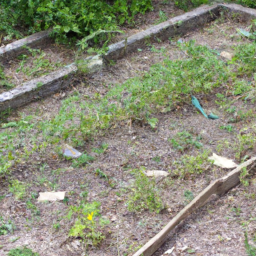Clearing Weeds in a Vegetable Garden A How-To Guide
How To Clear A Vegetable Garden Full Of Weeds
How To Clear A Vegetable Garden Full Of Weeds
Assessing The Garden's Condition&8211;
The first step in clearing a vegetable garden full of weeds is to evaluate the situation and decide on the best course of action. Before tackling the weed infestation, it's important to determine if the garden requires complete removal or if selective weed control methods can be employed. This will help you decide if herbicides, physically removing weeds, or other specific control measures are needed.
key milestones:
- Evaluating the condition of your garden
Preventative Measures
Second, it is important to take preventive measures to keep weeds under control. Proper soil preparation and fertilization prior to planting is key. Preparing raised beds or even a raised planter box may also help reduce the risk of weeds. Mulching with organic materials such as hay and straw is beneficial for reducing weed growth and retaining moisture. Additionally, manual removal during the growing season is necessary to keep weeds under control.
key milestones:
- Preparing soil prior to planting
- Fertilizing
- Mulching
- Regularly removing weeds
Herbicide and Chemical Treatments
Herbicide and chemical treatments can be an effective way to control weeds in a vegetable garden. However, because these substances can also harm plants, it is important to read and follow application instructions carefully. Chemical control must also be done before the weeds have gone to seed, as many can spread quickly and should be targeted as early as possible.
key milestones:
- Read and follow application instructions for herbicides
- Use chemical treatments before weeds have gone to seed
Use of Cover Crops
Cover crops such as clover, rye grass, and buckwheat can help suppress weed growth by covering bare ground and shading the soil. Cover crops are often planted after a garden is harvested and until the next planting season. They can reduce or eliminate the need for herbicides and manual weeding.
key milestones:
- Use cover crops to prevent weeds
- Plant a cover crop after harvesting
- Can reduce or eliminate need for herbicides and manual weeding
The Benefits of Composting
Composting is a great way to improve soil fertility and health. Adding compost to a garden helps reduce the prevalence of weeds by improving soil structure and increasing microbial activity. Compost should be worked into the soil prior to planting and at least twice throughout the growing season.
key milestones:
- Improve soil structure and increase microbial activity
- Work compost into soil prior to planting
- Add compost twice throughout the growing season
Crop Rotation
Crop rotation involves growing different crops each season to prevent weed growth. Rotating crops prevents weeds from building up in the soil and reduces the need for herbicides. It is also an effective way to preserve soil health and fertility.
key milestones:
- Plant different crops each season
- Prevents weeds from building up in the soil
- Reduces the need for herbicides
- Preserves soil health and fertility
Insights
Clearing a vegetable garden full of weeds requires some upfront assessment and planning prior to tackling the weed infestation. While herbicides and chemical treatments can help, there are also other proactive strategies that can be employed such as mulching with organic materials, applying compost, and crop rotation. Keeping the garden free of weeds requires some level of maintenance and should be done regularly throughout the growing season, but the effort can go a long way in keeping your vegetable garden healthy and free of weeds.

Previous Page
